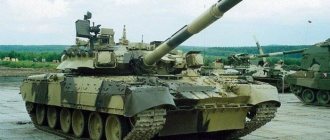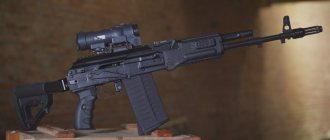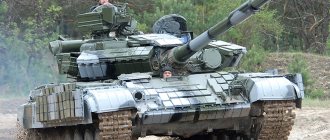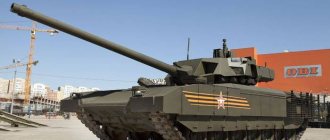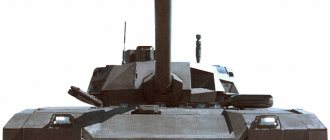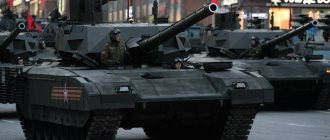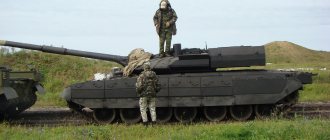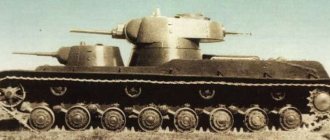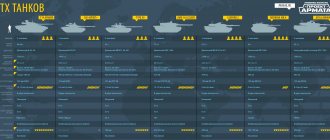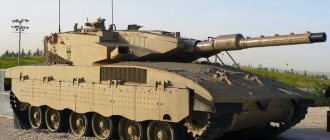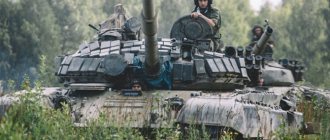The T-15 heavy infantry fighting vehicle (object 149) is a promising Russian-made armored fighting vehicle, designed on the Armata universal tracked platform. It is designed to transport motorized rifle units, conduct all types of combat and fire support for dismounted riflemen. A special feature of the T-15 infantry fighting vehicle, created on the same platform as the promising Russian T-14 Armata tank, is an unprecedentedly high level of protection, which gives it the ability to operate in the same line as tanks.
The first official display of the T-15 took place at the Victory Parade in Moscow on May 9, 2015. But then the promising Russian infantry fighting vehicle remained “in the shadows,” because the public’s main attention was on the newest T-14 Armata tank. In this article we will provide detailed information about the T-15 BMP.
© Material prepared for the portal “Modern Army” https://www.modernarmy.ru
BMP T-15 Armata TTX. Video. Photo. Speed. Armor
T-15 (GBTU Index - Object 149) is a promising Russian infantry fighting vehicle based on the Armata universal tracked platform. Designed for conducting all types of combat operations and transporting units of motorized rifle troops and fire support for dismounted riflemen.
PROSPECTS
Currently, the T-15 BMP is being refined and prepared for State tests, which will take place in 2016-2017, after which mass production will begin. The exact number of infantry fighting vehicles planned for production has not yet been determined; it is only known that the total volume of combat vehicles on the Armata platform, provided for by the State Armament Program until 2022, will be 2,300 units. Thus, the T-15 “Barberry” will be the first heavy infantry fighting vehicle (with protection at the level of a main tank) in the Russian Armed Forces.
In the future, it is planned to create a KShM vehicle based on the T-15 (BMP-KSh). The advantage of such a machine over existing manual landing gear will be much more reliable protection. This will allow commanders, for example, at the battalion level, to manage their unit with minimal risk while directly on the battlefield. The large internal volume of the BMP-KSh will allow any equipment and workplaces for staff officers to be placed inside the vehicle.
Currently, not all technical features of the T-15 BMP are open to the general public due to the secrecy regime. However, even what is known allows us to talk about the appearance in the Russian army of a fundamentally new infantry fighting vehicle with combat effectiveness an order of magnitude higher than existing models.
BMP T-15 - video
It was first demonstrated at the Victory Parade in Moscow in 2015. The period of state tests is 2016-2017, after their completion mass production will begin. It will become the first heavy infantry fighting vehicle (heavily armored at the level of the T-14 tank) in the Russian Armed Forces.
In 2016, an order was received for the production of an unknown number of T-15s.
The T-15 BMP has tank level armor and Afghanit active protection, which allows the BMP to fight in the same formation with Armata T-14 tanks. The presence of modern missile weapons from the Kornet ATGM and anti-aircraft gun allows you to effectively fire at both ground and air targets.
Concept and application prospects
The T-15 BMP is a network-centric warfare combat vehicle, that is, it is capable of transmitting data on detected targets for destruction to other tactical-level vehicles and, in turn, receiving tasks from them to destroy targets adequate to the BMP’s armament. The practical implementation of such a scenario is carried out through a unified tactical level control system.
Designed to conduct maneuverable combat operations against any enemy in tank and motorized rifle units as the main multi-purpose combat weapon in conditions of the use of nuclear weapons and other types of weapons of mass destruction.
The anti-tank system is designed to defeat modern tanks with active protection systems.
The infantry fighting vehicle has clear support for operating as a close-combat air defense system with an emphasis on destroying UAVs and Apache-class anti-tank attack helicopters.
Unmanned aerial vehicle
According to the developers, the T-15 BMP will have a launcher for an unmanned aerial vehicle for reconnaissance of targets and study of the surrounding environment. The specific type of UAV is determined during testing of devices provided by various Russian suppliers. Apparently we are talking about a light tactical UAV of the T23 Eleron class and installation of a launch catapult on an infantry fighting vehicle for such a UAV.
Combat module options
Due to the modularity of the Armata platform, the T-15 is expected to use several variants of combat modules, depending on the tactical use of the infantry fighting vehicle.
Option with Boomerang-BM combat module
The Boomerang-BM combat module of circular rotation uses a 30-mm 2A42 automatic cannon with selective ammunition supply and a coaxial 7.62-mm PKT machine gun, as well as two twin launchers for the Kornet ATGM. It was reported that the ammunition would consist of 500 cannon shells, 2,000 machine gun rounds and four 9M133 anti-tank missiles or 9M133FM-3 air defense missiles.
The 2A42 cannon on the Boomerang-BM combat module allows for effective fire:
- in terms of manpower - up to 4000 m; - for lightly armored vehicles - up to 1500 m; - against air targets - up to an altitude of 2000 m (with subsonic speeds and slant range up to an altitude of 2500 m).
The computerized fire control system (FCS) will include two multifunctional sights: one for the gunner, the other for the vehicle commander, as well as a radar station, an advanced sensor system and a two-plane weapon stabilizer.
The automatic target tracking system will allow you to fire with high accuracy over the entire firing range from a standstill and on the move. The sights, judging by the photographs, have a large number of channels and will largely duplicate each other, which is very important when used remotely.
Unlike other infantry fighting vehicles in NATO arsenal, the Boomerang-BM combat modules, and especially the 57-mm Baikal, have clear support for the scenario of operation in close-range air defense mode, with passive detection of aircraft using television and infrared optical instruments, as well as the destruction of modern tanks equipped with active protection systems.
The Bumerang-BM OMS allows you to:
— Automatic search for targets simultaneously in different spectral ranges in passive and active modes; — Search for camouflaged targets using an optical locator; — Simultaneous shelling of two targets; — Highly effective shooting from AP at anti-aircraft targets with automatic tracking at angles of up to 70 degrees at an altitude of up to 2500 meters at a distance of up to 4 km; — Combat work in remote control mode; — Work on external target designation (including from radar with AFAR T-14);
Option with Baikal combat module
Deputy General Director of the Uralvagonzavod corporation Vyacheslav Khalitov announced the creation of an AU200M “Baikal” combat module with a 57 mm automatic cannon for the Armata T-15. The gun was converted from a ship's anti-aircraft gun into a combat module for installation on the Armata chassis. "Baikal" is designed to enhance firepower against armored air targets such as attack aircraft and heavy attack helicopters with an increase in the ceiling of destruction to 8,000 meters and a range of up to 12,000 meters.
The Baikal combat module has relatively inexpensive projectiles with remote detonation. Although the trajectory of such projectiles is not adjustable, the projectile flying in maximum proximity to the target object explodes, hitting it with several thousand shrapnel balls. This allows you to hit small objects such as UAVs, which are almost impossible to hit directly.
AU220M “Baikal” is a Russian uninhabited combat module with a 57-mm cannon developed by the Burevestnik Central Research Institute.
Presumably this is what the T-15 infantry fighting vehicle with the AU220M “Baikal” combat module will look like.
Self-propelled mortar variant
General Director of the Central Research Institute "Burevestnik" Georgy Zakamennykh also announced that the T-15 will also be created as a combat module version with a 120 mm mortar, created on the basis of the 2S12 "Sani" mortar.
Missile weapons
The Kornet-EM ATGM is equipped with a 9M133FM-3 missile, designed to destroy air targets, including small UAVs, and for this purpose it has a high-explosive principle of destruction. The maximum operational altitude of the 9M133FM-3 is 9 km, which is higher than the ceiling of the US heavy attack UAVs of the MQ-1 Predator type (7.2 km). Also, the 9M133FM-3 allows you to confidently hit unarmored Apache-class helicopters on oncoming and catch-up courses at a range of up to 10 km, which is greater than the range of their anti-tank weapons - Hellfire missiles, which have a firing range of 8 km in most modifications. Cruise missiles and low-flying aircraft can only be hit by the 9M133FM-3 on a collision course.
To combat promising active tank protection systems, the Kornet-EM ATGM supports a salvo launch of two missiles at once with a delay less than the minimum response time of active tank protection systems.
The presence of a supply of missiles for destroying air targets, as well as the need to spend two missiles to destroy tanks with modern KAZs, determine the fact that the T-15 has 4 missile launch units, instead of 2 launch units for most infantry fighting vehicles with fighting compartments of a lower class without the ability to fire at air targets and destroy modern tanks with a simultaneous salvo of 2 missiles.
Security technologies
The T-15 has a tank armor level at the level of the Armata T-14
Passive booking
The T-15 uses common passive armor elements for the Armata platform:
— Frontal composite armor is impenetrable for modern ATGMs with a caliber of up to 150 mm and BOPS with a caliber of up to 120 mm — The logistics compartment, ammunition compartment and fuel compartment are isolated from each other by armored bulkheads
The photograph of the T-15 shows a system for reducing visibility in the infrared range due to exhaust diffusers, visible as an “impeller” on the front of the infantry fighting vehicle.
Dynamic armor complex Malachite
The T-15 is equipped with a new version of dynamic reservation common to the Armata platform, which can also be implemented electronically. At the moment, the developers have only disclosed data that the Malachite VDZ is capable of breaking shells inside itself and reflecting heavy ATGMs. The safety of the VDZ for tanks and infantry is declared by reducing the amount of explosive used by the VDZ to destroy ammunition.
Afganit active protection complex
Vehicles of the Armata family are equipped with the Afganit active protection complex, which also serves as a reconnaissance radar. The complex's capabilities include:
— Interception of projectiles by destruction — Interception of missiles by destruction or blinding by multispectral curtains and electromagnetic weapons — The complex has a radio-optical radar superimposed on the AFAR radar data from infrared and ultraviolet cameras, which allows this complex to also perform the role of target reconnaissance
Content
- 1 Concept and application prospects
- 2 Unmanned aerial vehicle
- 3 Options for combat modules 3.1 Option with combat module Boomerang-BM
- 3.2 Option with Baikal combat module
- 3.3 Self-propelled mortar variant
- 5.1 Passive reservation
Tactical and technical characteristics of the T-15 BMP
— Crew, people: 3 — Troops, people: 9 — Developer: UKBTM — Manufacturer: Uralvagonzavod
Weight of BMP T-15
— 50 tons
Armor BMP T-15
— Armor type: Combined multilayer
Armament of the T-15 BMP
— Gun caliber and brand: 1 × 30 mm 2A42 — Gun type: automatic gun — Machine guns: 1 × 7.62 mm PKTM — Other weapons: 4 × Kornet-EM ATGM
Engine BMP T-15
— Engine type: diesel — Engine power, l. pp.: up to 1500
Speed of BMP T-15
— Speed over rough terrain, km/h: 45-50 — Fuel tank capacity, l: 500 — Suspension type: controlled vane shock absorbers, hydraulic stops
Literature
- Suvorov S.
"Armata" and others. Heavy infantry fighting vehicle T-15 (Russian) // Equipment and weapons yesterday, today, tomorrow: magazine. — 2015. — December (No. 12). — P. 02-07. — ISSNT-44 · T-54 · T-55 · Object 416
·
Object 141
·
Object 139
·
Object 907
·
Object 140
·
Object 142
·
Object 430
·
Object 435
·
Object 167
· T-62 · T-62A ·
Object 920
· T-64
[/td]Medium tanks Heavy tanks IS-3 IS-4 IS-7 · T-10 ·
Object 266
·
Object 277
·
Object 278
·
Object 279
·
Object 770Missile tanks IT-1 · Item 64992 ·
Object 170
·
Object 431
·
Object 757
·
Object 772
·
Object 282
·
Object 906B
·
Object 775
·
Object 287
·
Object 780Flamethrower tanks OT-54 · Object 483 TO-55
BMPT Object 781 ·
Object 782
·
Object 787
· Object 199 "Frame"* ·
BMPT-72Main battle tanks T-62B · T-64A · T-64BV ·
Object 476
·
Object 172
·
Object 172-2M
· T-72 · T-72A · T-72B · T-72BA · T-72B3 · T-74 ·
T
-80 ·
T- 80A
·
Object 478
·
Object 785
·
Object 187
·
Object 477
·
Object 292
· T-80U · T-80UD · T-90 ·
T-90AM
·
Object 640
·
Object 195
·
T-14 (based on TSUP "Armata")ATGM combat vehicles 2P27 "Bumblebee" · 2P32 "Phalanx" · 9P19 "Eye" · 9P110 "Malyutka" · 9P122 "Malyutka-M" · 9P124 "Phalanga-M" · 9P133 "Malyutka-P" · 9P137 "Flute" · 9P148 "Konkurs" · 9P149 "Sturm-S" · 9P157 "Chrysanthemum-S" · 9P161 "Kornet-S" · 9P162 "Kornet-T"
Combat reconnaissance vehicles BRDM-1 Object 760 (“hover tank”) ·
BRDM-VPK
·
BRDM-VPS
·
Object 8M-906
· BRDM-2 · BRDM-3 · BRM-1K ·
BRM-2
· BRM-3K ·
BKM Airborne Forces "Vydra"
·
Patrol-AFlamethrower combat vehicles BMO-1 · BMO-T Armored personnel carriers K-75 · BTR-40 ·
BTR-112
·
K-78
· BTR-152 ·
ZIS-153
· BTR-50 ·
BTR-E152V
·
ZIL-153
·
GT-L
·
GT-LB
·
Object 1015
· BTR-60 · MT-
D
· BTR-70 · BTR-80 · BMM-80 · BTR-82 · BTR-90
·
BTR-T
· BTR-MD “Rakushka” ·
BMM-D
“ Boomerang " DT
-3PB
"
KrymskArmored vehicles Ural-4320-09-31 Ural-E4320D-31 Ural-E5323D GAZ-39344 ·
"Warrior"
·
"Bear"
·
Ural-6320
· "Typhoon" · ("Typhoon-U" ·
Ural-63099
· "Typhoon-K" ·
KAMAZ-63969
) · "Vodnik" · "Shot" · "Tiger" ·
"Wolf"
·
"Scorpion LTA"
·
"Bulat"
·
"Highlander-K"
·
"Federal-M" ("Stargazer")
·
"Scorpion LSA-B"ASU-76 ·
K-73
· SU-100P ·
SU-100M
· ASU-57 ·
BSU-11-57F
·
Object 574
· ASU-85 · SU-152
"Taran"
·
2S14 "Sting-S"
·
2S15 "Norov"
·
" Hermes"
· 2S25 "Sprut-SD" ·
2S28 "Sprut-K"
[/td]Anti-tank Self-propelled howitzers and mortars SU-152G ·
2A3 "Kondensator-2P"
·
2B1 "Oka"
·
Self-propelled guns with D-80
·
Self-propelled guns with D-80S
·
Self-propelled guns with D-80-2
· 2С1 "Gvozdika" ·
2С2 "Violet"
· 2С3 "Acacia" · 2С4 " Tulip" · 2S5 "Gyacinth-S" · 2S7 "Peony" ·
2S8 "Astra"
· 2S9 "Nona-S" ·
2S11 "Gyacinth-SK"
· 2S12B "Tundzha-Sani"* ·
2S17 "Nona-SV"
·
2S17 -2 "Nona-SV"
·
2S18 "Pat-S"
·
Object 327
· 2S19 "Msta-S" ·
2S21 "Msta-K"
·
2S22 "Flask-3"
·
"Compartment"
· 2S23 "Nona-SVK" · 2S24 "Virgo" ·
2S26 "Pat-K"
·
2S27 "Reef"
·
"Crimping"
·
2S30 "Iset"
· 2S31 "Vena" ·
2S33 "Msta-SM"
· 2S34 "Khosta" ·
2S35 "Coalition-SV"
·
Koalitsiya-SV-KSh
2S36
"Zauralets-D"Coastal A-222 "Bereg" BM MLRS and OTRK TZM 9T451 "Grad-1" · TZM "Grad-VD" · TZM-T “Solntsepek”
SPU SPU 2P2 "Mars" · SPU 2P4 "Filin" · SPU 2P5 "Korshun" · SPU 2P16 "Luna" ZSU-37-2 "Yenisei" ·
Object 130
[/td]37 mm 30 mm 2S6 "Tunguska" · 96K6 "Pantsir-S1" · ZPRK "Roman" ·
ZSU TKB-841 "Pantsir-S1-O"23 mm ZSU-23-4 "Shilka" BM air defense systems and air defense systems Strela-10 BM 9A35 SAM 9K35 "Strela-10-SV" Pine BM SAM "Sosna" Wasp BM 9A33B SAM 9K33 “Osa” Thor BM 9A330 SAM 9K330 “Tor” Cube SURN 1S91 SAM 2K12 "Kub" · SPU 2P25 SAM 2K12 "Kub" · SOU 9A38 SAM 2K12M4 "Kub-M4" Beech KP 9S470 SAM 9K37 "Buk" · SOC 9S18 SAM 9K37 "Buk" · SOU 9A310 SAM 9K37 "Buk" · PZU 9A39 SAM 9K37 "Buk" · RPN 9S36 SAM 9K317 "Buk-M2" Circle SOC 1S12 SAM 2K11 "Krug" · SNR 1S32 SAM 2K11 "Krug" · SPU 2P24 SAM 2K11 "Krug" S-300V KP 9S457 air defense system 9K81 "Antey-300" · radar 9S15 air defense system 9K81 "Antey-300" · radar 9S19 air defense system 9K81 "Antey-300" · MSNR 9С32 air defense system 9K81 "Antey-300" · PU 9А82 air defense system 9K81 "Antey-300" · PU 9A83 ZRS 9K81 "Antey-300" · ROM 9A84 ZRS 9K81 "Antey-300" · ROM 9A85 ZRS 9K81 "Antey-300" Cranes KT-15 · SPK-5 · SPK-12G BIS UR-67 · UR-77 · UR-88 ·
UR-93
· UR-07 · BMR-1 · BMR-2 · BMR-3 · BMR-3MIMR IMR-1 IMR-2 IMR-3 IMR-3M "Klin-1" AZM ·
ADZM "Vostorg-2"
· BAT-M · BAT-2RHM BRDM-2РХБ · РХМ · РХМ-2 · RKhM-3 · РХМ-4 · РХМ-5 · РХМ-6 · РХМ-7
BREM BREM-1 BREM-2 BREM-3 BREM-80U BREM-L BREM-D BREM-K RM-G
MTU MTU · MTU-20 · MTU-55 · MTU-72 · MTU-90 ICC MTP-1 · MTP-2 · MTP-3 · MTP-A5 Other SPU-117 · IRM · IPR · VTS · KDHR-1N · BTZ-3 · LKM-1 · LKM-3 · P-256G · RPM-2 · KhTV-64 · SPM
PRP and PPU PRP-3 "Val" · PRP-4 "Nard" · PRP-4M "Deuterium" · PPRU-1 "Gadfly-M-SV" · 9S482 (PU-12) · 9S482М6 (PU-12М6) · 9S737 "Rank" · 9S737M "Rangir-M" · 15Y56 (MBP) · "Palantin-P" KSAUO 1B13 1B14 1B15 1B16 Object 940 · 1В18 "Klen-1" · 1В19 "Klen-2" · 1В117 · 1В118 · 1В119 "Rheostat" · 1В152 · 1В157 · 1В21 · 1В22 · 1В23 · 1В24 · 1В25 · 1В31
Radar 1RL232 “Leopard” · SNAR-15 "Selenite" · 1RL239 “Lynx” · 1Л219 “Zoo”
electronic warfare 1L21 (SPR-1) 1L29 (SPR-2) 1K11 "Stiletto" ·
“Sanguine”
·
1K17 “Compression”* - produced only for export; italics Promising, experimental, or samples that did not go into mass production were identified
Give me some ammo!
At the same time, the optical instruments of the new BMPT will make it possible to conduct targeted fire at both small UAVs and attack and reconnaissance helicopters at a range of up to 6-7 thousand m, and the maximum firing range of a 57-mm caliber AP is up to 16 (!) km.
Of course, such firing distances are practically never encountered in armed conflicts, but the characteristics allow us to draw certain conclusions about the maximum operating modes of the guidance and fire control system. If everything turned out to be more or less obvious with the technical specifications for the vehicle, serious disputes flared up around the range of ammunition that should be included in the ammunition load of the new BMPT. A rough calculation of the ammunition consumption when firing at targets allows us to understand that instead of a series of shots from a 30 mm cannon (up to 15 shells), a 57 mm caliber gun will require one, maximum two shots, with which the target object on the battlefield will be hit. True, the composition of the promising vehicle’s ammunition still remains unknown.
BMPT_4
ATGM "Attack" mounted on the combat module
Photo: commons.wikimedia.org/Alexey Vasilenko
Izvestia’s source in the military-industrial complex notes that, along with a serious high-explosive fragmentation effect for 57-mm caliber guns, the third version of the BMPT may be equipped with armor-piercing sabot shells (APS), the armor penetration of which, according to various sources, can be about 200 mm. These ammunition (in theory) should be able to defeat enemy light armored vehicles in any projection at ranges of 2600–2900 m, and heavy armored vehicles in the side and rear projections. In addition, the third version of the Terminator BMPT may feature a special computer for projectiles with a programmable fuse. At the same time, as Izvestia’s sources note, we are not talking about confrontation with main battle tanks, and such a task is not even one of the priorities.
If, when developing a new BMPT, Russian specialists solve all the tasks set by the military, then a completely new type of vehicle may appear in the Ground Forces, the development of a direct competitor for which will take at least 10–15 years. The main thing, however, is different: the appearance of BMPTs on the battlefield will radically reduce the needs of armored vehicles for infantry escort, making a new round in the “depopulation” of the battlefield and, as a result, reducing the losses of combat units.
